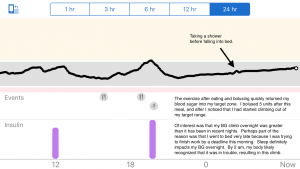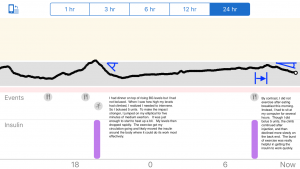Yesterday’s data tells me two interesting things: 1) My new insight into bolusing AND exercising carefully to rapidly drop my blood sugar levels is paying dividends, and 2) Not going to be early may be hurting my blood sugar control. Let’s start with this second point.

I didn’t hit the pillow before 2 am last night. You can see the blip in the climbing level that indicates where I took my shower just before bed. As my body detected that I was not going to hit the hay, and it drew on stress hormones to keep me awake, my blood sugar levels started to rise. That trajectory continued throughout the night at a remarkably even rate.
My mother always campaigned that the hours of sleep before midnight were worth twice the hours after midnight. My wife recently heard from a friend that the restorative energy of the body is given to repair if the body is asleep by 10:30 pm or so (in adults). If the person is not asleep, then that energy that would have gone to repair is redirected toward staying awake. The upshot is that the body misses that day’s repair. I can only imagine how much deferred maintenance I’ve accumulated over the years. It may be a large contributor to my having become diabetic in the first place. I don’t have any proof of that, but I’m suspicious that it might have played a part.
The first point I found interesting was to see how a little exercise (as in five (5) minutes) with insulin could bring my levels down much faster than just insulin alone.

You can see on the left how quickly my levels dropped with only five (5) minutes of elliptical. It was just enough to feel myself start to get a little warm. The next morning, I was not physically active at all. The result was that there was a latency in the effectiveness of the insulin of about an hour, and the rate at which it dropped my levels was much lower. I’ve inserted relative angle sketches to emphasize the contrast.
There is also likely a difference between gradual walking and an intense burst of exercise. I’ll have to do some experiments between those two scenarios to see what conclusions I might draw.